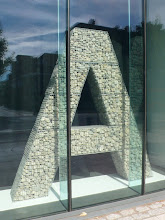Re-reading Species of spaces by Georges Perec (1999) I noticed he makes various spatial points about the page.
I write: I inhabit my sheet of paper, I invest it, I travel across it.
Perec 1999: 11
This is how space begins, with words only, signs traced on the blank page.
Perec 1999: 13
So, what does this have to do with liminal? Well I was wondering whether it is the page that acts as this threshold. Indeed, for Perec, it seems that the page is where the words are read and come alive for the reader. This is in direct contrast to Ingold (2007: 26) who thinks the space of the page has been 'silenced' since mechanical print.
This reminds me of Saussure's idea that sound and thought cannot be divided. He uses the image of a sheet of paper as a metaphor for this—one is not able to cut the front without cutting the back at the same time. They are inextricable linked, interdependent. Perhaps the same could be said of typography and the page. In a simplistic sense, the type literally becomes part of the fabric of the page as the ink bleeds. One becomes part of the other.
Beyond this chemical reaction I would also suggest something more alchemical is possible. The page is not, in a traditional sense, a physical landscape, but it can act as a gateway to place in the mind, an it is the possibilities offered by a holistic approach to typography, content and form (perhaps another indivisible pairing) that can open up such a space. The page is therefore the threshold between words and the imagination. I think this is regardless as to whether the typography has been executed by hand, digitally or using letterpress—it is the fusing of the pairs: type and page; form and content that is key for me, not the link between the hand and the page as Ingold believes.


2 comments:
A very nice metaphysical philosophical stance. I like the idea of the page being a threshold/door to the mind.
Thanks Tony. Works that spring to mind for me in this regard are Nick Bell's Hmm pages for Emigre a few years ago. I have always been really taken by these, but maybe hadn't worked out why until now. They seem so minimal in their form, but, to me, so powerful in their effect.
Post a Comment